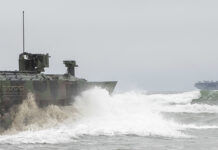BAE Systems took the opportunity at the LIMA 2023 defence exhibition, held in Langkawi from 23 to 27 May 2023, to brief on Project OdySSEy: the company’s concept for developing a single synthetic training environment to enable collective military training.
Speaking to reporters on 24 May, the company’s senior military advisor, former Royal Air Force (RAF) chief Sir Andy Pulford, outlined the training dilemma produced by the latest platforms and weapon systems. “Not only is the future bringing in more capable rates of distance, higher-speed weapons, but it is challenging our ability to train,” he explained. “Even some of the ranges in the [United] States are not able to provide the distances required. … Our traditional ranges are not big enough.”
An additional dilemma, Pulford noted, is that “the capabilities themselves you don’t necessarily want to demonstrate for the enemy to see. We used to talk about satellites coming over and satellite windows; it’s now a virtually constant stare anywhere on the world by your potential enemy.”
Consequently, to a substantial extend armed forces training needs to be taken into a synthetic environment where a potential enemy cannot monitor it.
Pulford added that “a real intention now for multi-domain operations, beyond some interoperability and co-ordination, is actually thinking of military capability in a truly harmonised way across the three traditional domains plus cyber and space”. This necessitates synthetic training on a scale not currently possible: a challenge that Project OdySSEly intends to overcome.
“Potentially we’re looking at 60,000 players being able to play in the same scenario, using the same digitised environment,” Pulford noted. “This is ground breaking.
“We used to think of just simulating a cockpit; what we’re talking about now is simulating the whole environment, so not just flying your aircraft, but flying with a flight of aircraft, operating with a Type 45 frigate – augmented reality, virtual reality, and potentially at some stage real flying as well.
“We tend to think you get trained and then you’re on the front line, but it’s then how you actually generate combat capability, how do you keep it ready, how do you keep it relevant,” said Pulford. “We won’t be able to do that only in the real world, and something like OdySSEy is going to provide the vehicle for armies and navies and air forces to do that. Imagine being able to put a 60,000-element exercise together – and also extend that into other nations.”
To progress Project OdySSEy Pulford noted that BAE Systems is working with a number of smaller entities that are subject matter experts in the synthetic and gaming domains. “They’re very exciting young companies at the leading edge of those aspects of digital training,” he said.
The companies concerned include Bohemia Interactive, D3A Defence, Hadean, Inzpire (which is now owned by BAE), Pauley, Pitch Technologies, PLEXSYS, uCrowd and VRAI.
In March BAE hosted a proof-of-concept trial for Project OdySSEy at its facility in Warton, Lancashire, where the team came together to run a full demonstration of the core capability developed. This concluded Phase 1 of the capability development, so the company is now looking to develop the complexity and capability of that core capability through Phase 2 of the project, which runs until March 2024.
Meanwhile, Pulford confirmed to ESD that BAE Systems is talking to entities outside the UK about Project OdySSEy “and we will be looking to sell it to customers within the context of how we do business”.
He also added that elements of Project OdySSEy will feed into Gladiator: the current Boeing Defence UK-led programme to provide a synthetic training platform for the RAF in which BAE is also involved.
Ultimately, however, the project is looking further into the future, with Pulford asserting that “what fits into OdySSEy will only be limited by your imagination”.
Peter Felstead












